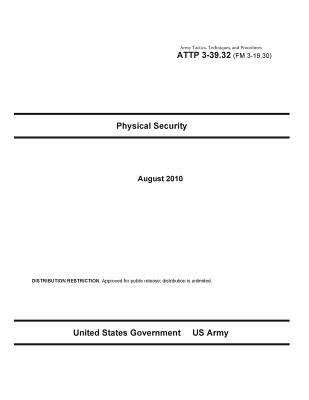
Army Tactics, Techniques, and Procedures ATTP 3-39.32 (FM 3-19.30) Physical Security
Description
ATTP 3-39.32 provides doctrinal guidance for personnel who are responsible for planning and executing physical security programs. It is the basic reference for training security personnel. ATTP 3-39.32 is organized into 11 chapters and 6 appendixes, which provide additional details on selected physical security topics. A brief description of each chapter and appendix follows. -Chapter 1, Physical Security Challenges, describes how the physical security program supports the principles of the protection warfighting function through the coordinated efforts of policies, plans, and procedures that are specifically designed to achieve a strong protection posture. -Chapter 2, Physical Security Planning, describes how planning committees, such as the protection working group, play an integral part in the planning process. The chapter introduces the Army Military Police Security Management System countermeasures as the primary planner's tool for physical security surveys and inspections. -Chapter 3, Site Design Approach, lays the foundation for initial security design planning considerations that are required for new construction, renovation, and temporary structures. The chapter discusses perimeter and internal security systems. -Chapter 4, Protective Barriers, describes emplacement considerations of barriers and fencing (to form the perimeter of controlled areas) and passive and active vehicle barriers (to impede, channel, or stop vehicle traffic). -Chapter 5, Security Lighting, provides the principles of security lighting and technical information for the minimum levels of illumination and lighting uniformity required for various applications. -Chapter 6, Electronic Security System, describes the five major components of electronic security systems (ESSs) and provides technical data concerning electronic interior and exterior sensors and alarm systems. -Chapter 7, Access Control Points, discusses the policies, technical guidance, and procedures used at Army access control points (ACPs). The chapter describes the four ACP zones and the procedures for vehicle inspection and hand-carried item examination. -Chapter 8, Key Control and Locking Systems Security, describes the duties and responsibilities of the key custodian, describes procedures for key and lock control, and provides technical information on the various types of locking devices. -Chapter 9, Security Forces, highlights the authority and jurisdiction of security forces, describes various types of security forces, and discusses the development of comprehensive security plans and orders. -Chapter 10, Physical Security for In-Transit Forces, describes risk management for deploying forces and security procedures for in-port cargo and rail cargo protection. -Chapter 11, Resource Management, lays out the foundation for documenting physical security resource requirements, conducting program and budget reviews, prioritizing requirements, and identifying funding sources. -Appendix A, Sample Physical Security Plan, provides an example of a physical security plan and describes annexes required per AR 190-13. -Appendix B, Selected Reachback Capabilities, highlights various official organizations and agencies that provide useful information to enhance situational awareness for commanders and physical security planners. -Appendix C, Sample Physical Security Checklist, provides a guide for physical security personnel in developing checklists tailored to meet their specific needs. -Appendix D, Bomb Threats, offers a sample bomb-threat data card and provides guidelines for bomb-threat planning, evacuation drills, and search considerations. -Appendix E, Key Control Register and Inventory Form, shows a sample completed DA Form 5513 (Key Control Register and Inventory). -Appendix F, Sample Key Control and Lock Security Checklist, provides an example to help physical security personnel develop a key control checklist that is specifically desig.















